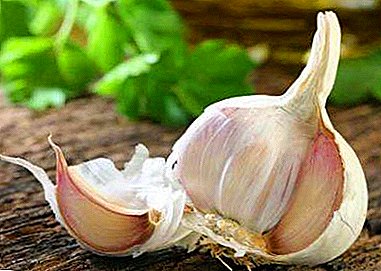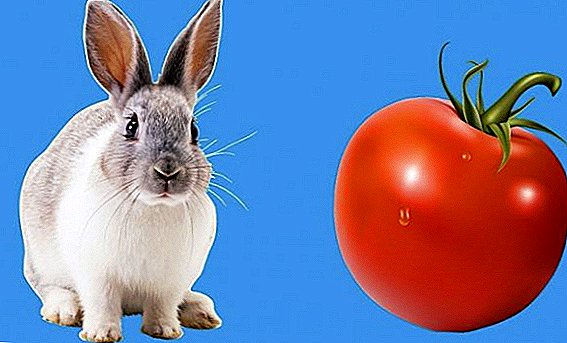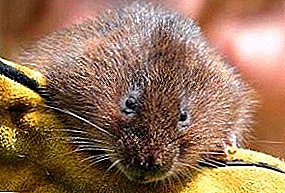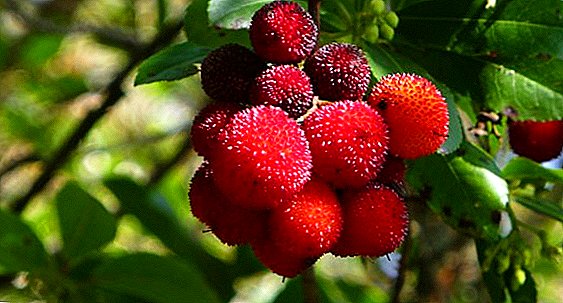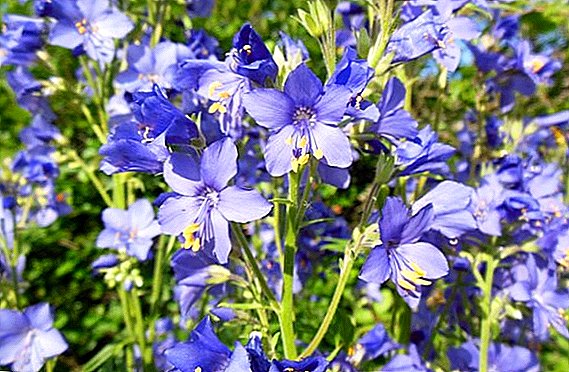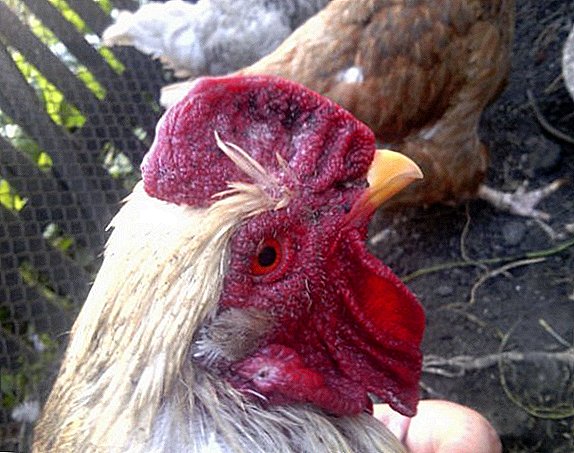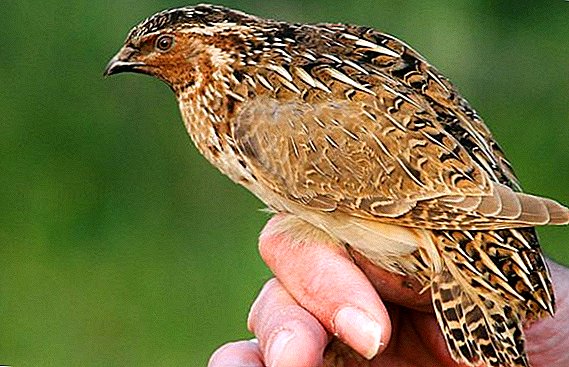 Strawberries, or garden strawberries - one of the first summer berries, the appearance of which is eagerly awaited by both children and adults. Therefore, the owners of suburban areas prefer to necessarily allocate at least a small area for its planting to feast on homemade juicy and healthy berries. It often happens that, for example, on six hundred square meters of land, you want to place as many crops as possible so that there are greens, and your vegetables, and various berries on the table. However, the site, as they say, is not rubber. In this case, cottage owners begin to look for varieties with high yields. If we talk about strawberries, then this is exactly variety "Elsanta", the characteristics of the cultivation of which will be discussed in this article.
Strawberries, or garden strawberries - one of the first summer berries, the appearance of which is eagerly awaited by both children and adults. Therefore, the owners of suburban areas prefer to necessarily allocate at least a small area for its planting to feast on homemade juicy and healthy berries. It often happens that, for example, on six hundred square meters of land, you want to place as many crops as possible so that there are greens, and your vegetables, and various berries on the table. However, the site, as they say, is not rubber. In this case, cottage owners begin to look for varieties with high yields. If we talk about strawberries, then this is exactly variety "Elsanta", the characteristics of the cultivation of which will be discussed in this article.
Did you know? Experienced gardeners have adapted to grow garden strawberries throughout the year - in apartment conditions on warmed balconies. So, the first harvest of strawberry "Elsanta" can be gathered not in June, but in December, having decorated the festive New Year's table with fresh home-made berries.
History of breeding strawberries varieties "Elsanta"
Strawberry "Elsanta" appeared thanks to the efforts of Dutch breeders not so long ago - the selection of the variety was carried out in 1981. He was the result of crossing two varieties - "Gorella" and "Holiday". Since then, with the characteristics of this variety of strawberries compare all the rest. "Elsanta" is included in the list of the best varieties and is a standard, a kind of measure of yield.
Did you know? The most popular berries "Elsanta" are used at home - in Holland and Belgium. There they are mainly grown in greenhouses on an industrial scale.
Variety description
 So let's take a closer look at the unique variety of strawberry "Elsanta", learning more about it from the detailed description. Let's start with the fruits - they are in this culture of a wide-conical rounded shape, small, bright red in color with a varnished gloss. Their flesh is bright red, juicy. In appearance the fruits are very appetizing. However, as well as to taste - they are sweet with a slight acidity, contain 7.3% sugar and 0.77% acid. Tastes of berries on the dessert scale are estimated at 4.7-5 points. They are small in size - they have an average weight of 45 g. Density can be added to their main advantages. They are well tolerated transportation and well stored at room temperature - up to three days. Fruits easily break away from the stem.
So let's take a closer look at the unique variety of strawberry "Elsanta", learning more about it from the detailed description. Let's start with the fruits - they are in this culture of a wide-conical rounded shape, small, bright red in color with a varnished gloss. Their flesh is bright red, juicy. In appearance the fruits are very appetizing. However, as well as to taste - they are sweet with a slight acidity, contain 7.3% sugar and 0.77% acid. Tastes of berries on the dessert scale are estimated at 4.7-5 points. They are small in size - they have an average weight of 45 g. Density can be added to their main advantages. They are well tolerated transportation and well stored at room temperature - up to three days. Fruits easily break away from the stem.
Bushes plants grow to medium size, are not scattered. They produce a small number of whiskers and outlets. The advantages of strawberries "Elsanta" must be recorded, of course, yield: from one bush it is possible to collect up to 1.5 kg per season and up to 74 kg per hectare of strawberry plantings. And also a long period of fruiting.
Another advantage of the plant is considered high resistance to viral diseases, good resistance to fungal blotch, verticillary wilt. In general, the variety can be called unpretentious - it does not require any additional care efforts and constant fertilizing.
Among the disadvantages of strawberry "Elsanta" - poor winter hardiness (up to -14 ºС) and drought resistance, susceptibility of root rot and powdery mildew.
 This grade is suitable for cultivation in an open ground and in the greenhouse. Recommended for cultivation in the middle lane and southern regions. The growing cycle is four years. Ripening strawberries "Elsanta" - medium.
This grade is suitable for cultivation in an open ground and in the greenhouse. Recommended for cultivation in the middle lane and southern regions. The growing cycle is four years. Ripening strawberries "Elsanta" - medium.
Berry is universal: suitable for fresh use, making jams, jams, freezing.
Preparatory work before landing
The best time for planting this variety is autumn, but not earlier than the second half of September. If you decide to plant it in the spring, then wait for smaller berries.
Important! You should not plant strawberries in hot weather, as this can provoke its withering and damage the root system.Land on the site before planting should be carefully prepared: plow, break all the earth lumps. Then pour well and leave in this condition for a day. After that, loosen the soil and make holes.
When planting the soil can (but not necessarily) fertilize organic or nitrogenous fertilizers. So, a mixture of humus or well-rotted compost (3 kg / 1 sq. M), potassium chloride (10 g), superphosphate (30 g) is introduced into the landing pits.
After this procedure, the soil under the bushes must be watered and covered with mulch from dry grass, humus, peat or compost. When planting in this way, strawberries will not need fertilizer until the fruiting period.
Strawberry planting scheme "Elsanta"
 The best method of planting for this variety will be a two-way - 30 × 30. The distance between the holes when the cluster landing should be left at least 25 cm, between the rows - 40 cm. You can also use a two-line ribbon planting scheme: 80 × 30 × 30. Elsanta strawberries are planted at a depth of 8 cm.
The best method of planting for this variety will be a two-way - 30 × 30. The distance between the holes when the cluster landing should be left at least 25 cm, between the rows - 40 cm. You can also use a two-line ribbon planting scheme: 80 × 30 × 30. Elsanta strawberries are planted at a depth of 8 cm.
Plant strawberries preferably in cloudy weather.
Agrotechnics growing strawberries varieties "Elsanta"
Since the drought tolerance of strawberry "Elsanta" is rather low, Special care should be taken when irrigating. It is especially important to regularly moisten the soil in the first month after planting. The first week of watering should be carried out daily. After - their number and volume is reduced to once a week. During the fruiting period, the soil is watered only as it dries easily. In hot weather, this procedure is carried out once in 4-5 days, using 8-10 liters of water per 1 square meter. m. In especially dry periods, which are accompanied by very high temperatures, strawberries need drip irrigation, as well as shelter from the scorching sun.
Important! Without additional watering and shading temperature + 35-40 ºC can be disastrous for strawberries.The strawberry care activities also include loosening the soil. It is carried out once every 10-15 days. Also, do not forget about the timely destruction of weeds.
Gardeners do not recommend fertilizing this variety. An exception can be made only for the third year of life.
Important! A characteristic feature of the grade "Elsanta" is its ability to harden. If it is not further fertilized in the first season, then in the future the berry is able to independently develop endurance and stability.
 If you still prefer to fertilize strawberries, "Elsante" will be enough two supplements - in spring and autumn. Spring dressing is carried out when the snow melts and steadily warm weather sets in. Fertilizers used during this period must contain a sufficient amount of nitrogen.
If you still prefer to fertilize strawberries, "Elsante" will be enough two supplements - in spring and autumn. Spring dressing is carried out when the snow melts and steadily warm weather sets in. Fertilizers used during this period must contain a sufficient amount of nitrogen.Autumn strawberries are fertilized in September. Use organic, mineral, mixed, green fertilizers, cooked with your own hands, or complex fertilizer for strawberries, purchased in a specialty store.
When using mineral fertilizers, one should be extremely careful and water only the aisle to prevent solutions from getting on the leaves of the plant. Also Do not move away from the dosage, so as not to harm the strawberries.
Preparing strawberries "Elsanta" for winter
Since the variety is thermophilic and does not tolerate frosts, an important part of plant care will be preparing it for winter. Autumn activities include leaf pruning and soil mulching. In addition, in the fall you should not stop watering the plants, because in September there is still often hot and arid weather. It is also necessary to take measures to control pests and diseases when they occur and remove the affected and decayed organs of the plant.
Do I need to cut strawberry leaves? This question has no definite answer. Opponents of this procedure prove that a person interferes with the natural development processes of the berry crop and, accordingly, harms it. They argue their point of view by the fact that strawberries with healthy leaves survive the winter more easily, as they help to save the buds from frosts. Supporters of removing leaves for the winter convince pruning entails an increase in yield next year.
 If you think this procedure is appropriate, then you need to know how to properly pruning, so as not to harm the plant. After fruiting, strawberry leaves are cut with scissors or shears. Better to do it in August. Cut only the leaf plate. It is important to leave the stems intact so as not to accidentally damage the growing point. All antennae are also subject to removal.
If you think this procedure is appropriate, then you need to know how to properly pruning, so as not to harm the plant. After fruiting, strawberry leaves are cut with scissors or shears. Better to do it in August. Cut only the leaf plate. It is important to leave the stems intact so as not to accidentally damage the growing point. All antennae are also subject to removal.
Some owners of strawberry beds simultaneously with pruning produce loosening and hilling bushes.
Next, the beds are abundantly watered and mulch the soil. Peat, conifer needles, dry leaves, and straw are used as mulch. Do not get rid of weeds in the fall, it is better to leave this procedure for spring. During this period, they are no longer dangerous for strawberries, but when they are removed, you can damage the roots of plants that do not have time to recover by winter.
"Elsantu" necessarily cover. For shelter suitable branches of conifers, straw, dry leaves, tops. You can also use special covering materials (agrotex, spunbond, etc.) with a density of 60 g / sq. m. They are stretched to the arc. When choosing a natural shelter, preference should be given to lapnik, which is well breathable and does not allow strawberry bushes to swell.
 It is important to remember that the shelter should be carried out only after the first frost. This will allow the plant to harden.
It is important to remember that the shelter should be carried out only after the first frost. This will allow the plant to harden.
If you are in search of the best for you variety of garden strawberries, We advise you to opt for strawberry "Elsanta", landing and care which will not give you any problems. But the abundance of the harvest will be pleasantly pleased.



